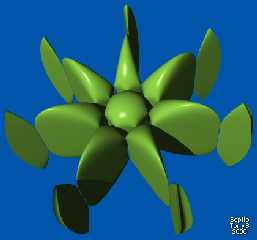 |
 |
|
 |
|
 |
|  |
|  |
|
 |
|
 |
|  |
|  |
|
 |
Here it is, the true septic in all its glory! A million thanks to both Ron
and Adam, especially Adam, without whose help this would not have been
possible. Enjoy.
//anthony bennett
//bennetts@panama.c-com.net
//http://welcome.to/TonyB
//8-12(01)2000
background {rgb <0,1,2>/3}
camera
{
location <1,1,-1>*65
look_at 0
}
light_source {<1,2,-3>*100 1}
#declare D = 0.2;
isosurface
{
function
z^2*(z-1)^2*(z+1)^2+D*(x^7-21*x^5*y^2+35*x^3*y^4
-7*x*y^6+7*x^6+21*x^4*y^2+21*x^2*y^4+7*y^6-56*x^4
-112*x^2*y^2-56*y^4+112*x^2+112*y^2-64)
method 2 max_gradient 100000 sign 1 threshold 0
bounded_by {sphere {0,6}} scale 6
pigment {rgb <2,3,1>/2.5}
finish {specular .5 roughness 1/200}
rotate x*70
rotate -y*5
rotate -z*10
}
Post a reply to this message
Attachments:
Download 'septic.jpg' (37 KB)
Preview of image 'septic.jpg'

|
 |
|  |
|  |
|
 |
|
 |
|  |
|  |
|
 |
Cool! I'm not about to pick apart that function, though :)
TonyB wrote:
> Here it is, the true septic in all its glory! A million thanks to both Ron
> and Adam, especially Adam, without whose help this would not have been
> possible. Enjoy.
>
>
> //anthony bennett
> //bennetts@panama.c-com.net
> //http://welcome.to/TonyB
> //8-12(01)2000
>
> background {rgb <0,1,2>/3}
>
> camera
> {
> location <1,1,-1>*65
> look_at 0
> }
>
> light_source {<1,2,-3>*100 1}
>
> #declare D = 0.2;
>
> isosurface
> {
> function
> z^2*(z-1)^2*(z+1)^2+D*(x^7-21*x^5*y^2+35*x^3*y^4
> -7*x*y^6+7*x^6+21*x^4*y^2+21*x^2*y^4+7*y^6-56*x^4
> -112*x^2*y^2-56*y^4+112*x^2+112*y^2-64)
> method 2 max_gradient 100000 sign 1 threshold 0
> bounded_by {sphere {0,6}} scale 6
> pigment {rgb <2,3,1>/2.5}
> finish {specular .5 roughness 1/200}
> rotate x*70
> rotate -y*5
> rotate -z*10
> }
>
> [Image]
--
Samuel Benge
E-Mail: STB### [at] aol com
Visit the still unfinished isosurface tutorial: http://members.aol.com/stbenge com
Visit the still unfinished isosurface tutorial: http://members.aol.com/stbenge
Post a reply to this message
|
 |
|  |
|  |
|
 |
|
 |
|  |
|  |
|
 |
TonyB wrote:
> Here it is, the true septic in all its glory! A million thanks to both Ron
> and Adam, especially Adam, without whose help this would not have been
> possible. Enjoy.
You're welcome, and Very nice!
So I also tried the (old-fashioned?) poly{7, <...>} on this, and it
worked pretty well.
... and as long as I'm noticing exponents, my version of the POV 3.1
docs (for poly) listed x^5z and x^5 where it seems x^6z and x^6 should
be. This persists in david sharp's (extremely useful) "poly objects
templates" code in the text.tutorials thread starting 5/23/99.
Adam C.
Post a reply to this message
|
 |
|  |
|  |
|
 |
|
 |
|  |
|  |
|
 |
Adam Coffman wrote >
[ ... ]
> So I also tried the (old-fashioned?) poly{7, <...>} on this, and it
> worked pretty well.
>
> ... and as long as I'm noticing exponents, my version of the POV 3.1
> docs (for poly) listed x^5z and x^5 where it seems x^6z and x^6 should
> be. This persists in david sharp's (extremely useful) "poly objects
> templates" code in the text.tutorials thread starting 5/23/99.
Yes, I noticed this probably about the same time as you when
attempting the same thing.
Post a reply to this message
|
 |
|  |
|  |
|
 |
|
 |
|  |
|  |
|
 |
Good to see you got it working...
Maybe when I have some more free time I'll look at the function, but seeing as
how it's not even second semester yet that won't be for a looooong while. The
loads of bullshit are piling up faster and faster now in school.
--
Homepage: http://www.faricy.net/~davidf/
___ ______________________________
| \ |_ <dav### [at] faricy net>
|_/avid |ontaine <ICQ 55354965> net>
|_/avid |ontaine <ICQ 55354965>
Post a reply to this message
|
 |
|  |
|  |
|
 |
|
 |
|  |
|
 |




![]()